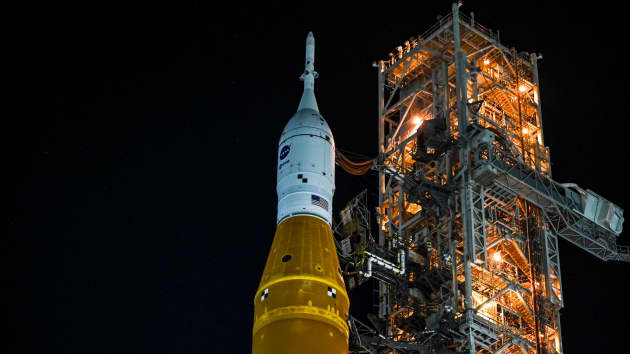- NASA plans to launch the Artemis I mission on Monday from Kennedy Space Center in Florida, sending the Space Launch System (SLS) rocket and Orion capsule on a more than month-long journey around the moon.
- The uncrewed launch marks the debut of the most powerful rocket ever assembled and kicks off NASA’s long-awaited return to the moon’s surface.
- Artemis I will travel about 1.3 million miles over the course of 42 days.
NASA plans to launch the Artemis I mission on Monday from Kennedy Space Center in Florida, sending the Space Launch System (SLS) rocket and Orion capsule on a more than month-long journey around the moon.
The uncrewed launch marks the debut of the most powerful rocket ever assembled and kicks off NASA’s long-awaited return to the moon’s surface. It’s the first mission in NASA’s Artemis lunar program, which is expected to land the agency’s astronauts on the moon by its third mission in 2025.
While Artemis I will not carry astronauts, nor land on the moon, the mission is critical to demonstrating that NASA’s monster rocket and deep space capsule can deliver on their promised abilities. Artemis I has been delayed for years, with the program running billions over budget.
The Artemis I mission represents a crucial turning point in NASA’s moon plans.
Despite the delays, and absorbing much of NASA’s relatively small budget by federal agency standards, the Artemis program has enjoyed strong bipartisan political support.
Officials in 2012 estimated that the SLS rocket would cost $6 billion to develop, debut in 2017 and carry a $500 million per launch price tag. But the rocket is only just now debuting, having cost more than $20 billion to develop, and its per launch price tag has ballooned to $4.1 billion.
NASA’s Inspector General, its internal auditor, earlier this year said Artemis is not the “sustainable” moon program that the agency’s officials say it is. The watchdog found more than $40 billion has already been spent on the program, and projected NASA would spend $93 billion on the effort through 2025 – when the first landing is planned.
But even that 2025 date is in doubt, according to NASA’s Inspector General, which said that development technologies needed to land on the moon’s surface are unlikely to be ready before 2026, at the earliest.
NASA’s Artemis plan relies on the success of another monster rocket as well: SpaceX’s Starship. The agency last year awarded SpaceX with a $2.9 billion contract to develop a moon-specific version of the rocket to serve as the crew lunar lander for the Artemis III mission.
SpaceX began testing of its Starship spacecraft in earnest in 2019, but that rocket has yet to reach orbit.
A host of aerospace contractors across the U.S. support the hardware, infrastructure and software for NASA’s Artemis I – Boeing, Lockheed Martin, Northrop Grumman, Aerojet Rocketdyne and Jacobs lead the effort. According to NASA, the Artemis program supports about 70,000 jobs around the country.
Multiple NASA centers are involved as well, beyond Kennedy as the launch site – including the DC headquarters, Marshall in Alabama, Stennis in Mississippi, Ames in California, and Langley in Virginia.
In the event that technical issues or weather delay the Aug. 29 launch attempt, NASA has back-up launch dates scheduled for Sept. 2 and Sept 5.
CNBC

Leave a Reply
You must be logged in to post a comment.